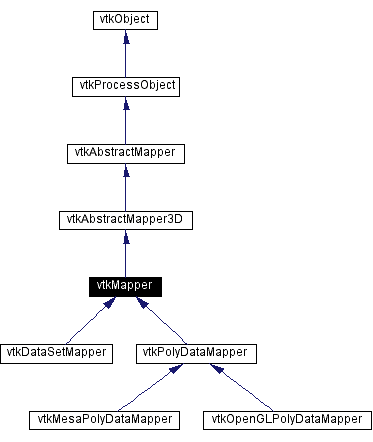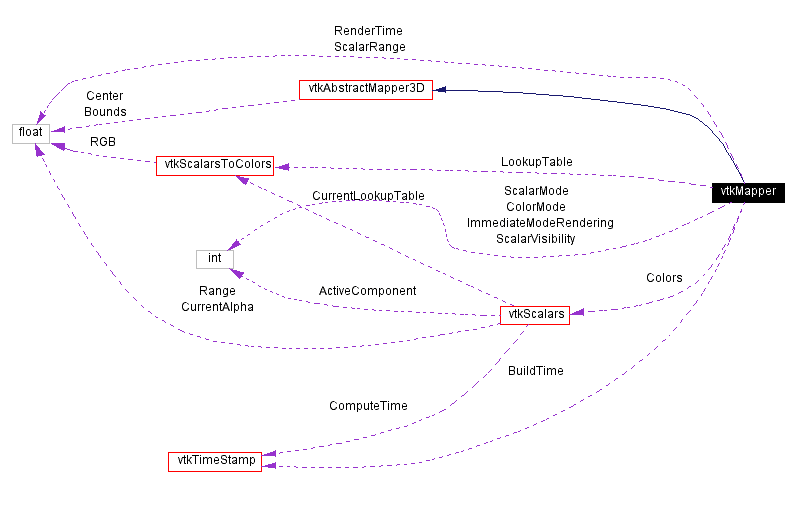Main Page Class Hierarchy Alphabetical List Compound List File List Compound Members File Members Related Pages
vtkMapper Class Reference
abstract class specifies interface to map data to graphics primitives.
More...
#include <vtkMapper.h>
Inheritance diagram for vtkMapper:
 [legend]Collaboration diagram for vtkMapper:
[legend]Collaboration diagram for vtkMapper: [legend]List of all members.
[legend]List of all members.
Detailed Description
abstract class specifies interface to map data to graphics primitives.
-
Date:
-
2000/12/10 20:08:42
-
Revision:
-
1.67
vtkMapper is an abstract class to specify interface between data and graphics primitives. Subclasses of vtkMapper map data through a lookuptable and control the creation of rendering primitives that interface to the graphics library. The mapping can be controlled by supplying a lookup table and specifying a scalar range to map data through.
There are several important control mechanisms affecting the behavior of this object. The ScalarVisibility flag controls whether scalar data (if any) controls the color of the associated actor(s) that refer to the mapper. The ScalarMode ivar is used to determine whether scalar point data or cell data is used to color the object. By default, point data scalars are used unless there are none, in which cell scalars are used. Or you can explicitly control whether to use point or cell scalar data. Finally, the mapping of scalars through the lookup table varies depending on the setting of the ColorMode flag. See the documentation for the appropriate methods for an explanation.
Another important feature of this class is whether to use immediate mode rendering (ImmediateModeRenderingOn) or display list rendering (ImmediateModeRenderingOff). If display lists are used, a data structure is constructed (generally in the rendering library) which can then be rapidly traversed and rendered by the rendering library. The disadvantage of display lists is that they require additionally memory which may affect the performance of the system.
Another important feature of the mapper is the ability to shift the z-buffer to resolve coincident topology. For example, if you'd like to draw a mesh with some edges a different color, and the edges lie on the mesh, this feature can be useful to get nice looking lines. (See the ResolveCoincidentTopology-related methods.)
-
See also:
-
vtkDataSetMapper vtkPolyDataMapper
-
Examples:
-
vtkMapper (examples)
Definition at line 103 of file vtkMapper.h.
Constructor & Destructor Documentation
| vtkMapper::vtkMapper |
( |
|
) |
[protected] |
|
| vtkMapper::~vtkMapper |
( |
|
) |
[protected] |
|
| vtkMapper::vtkMapper |
( |
const vtkMapper & |
|
) |
[inline, protected] |
|
Member Function Documentation
| virtual const char* vtkMapper::GetClassName |
( |
|
) |
[virtual] |
|
| int vtkMapper::IsTypeOf |
( |
const char * |
type |
) |
[static] |
|
| virtual int vtkMapper::IsA |
( |
const char * |
type |
) |
[virtual] |
|
| vtkMapper* vtkMapper::SafeDownCast |
( |
vtkObject * |
o |
) |
[static] |
|
| void vtkMapper::PrintSelf |
( |
ostream & |
os, |
|
|
vtkIndent |
indent |
|
) |
[virtual] |
|
|
|
Methods invoked by print to print information about the object including superclasses. Typically not called by the user (use Print() instead) but used in the hierarchical print process to combine the output of several classes.
Reimplemented from vtkAbstractMapper3D.
Reimplemented in vtkDataSetMapper, and vtkPolyDataMapper. |
| void vtkMapper::ShallowCopy |
( |
vtkMapper * |
m |
) |
|
|
|
|
Make a shallow copy of this mapper. |
| unsigned long vtkMapper::GetMTime |
( |
|
) |
[virtual] |
|
|
|
Overload standard modified time function. If lookup table is modified, then this object is modified as well.
Reimplemented from vtkObject.
Reimplemented in vtkDataSetMapper. |
| virtual void vtkMapper::ReleaseGraphicsResources |
( |
vtkWindow * |
|
) |
[inline, virtual] |
|
|
|
Specify a lookup table for the mapper to use. |
| virtual void vtkMapper::CreateDefaultLookupTable |
( |
|
) |
[virtual] |
|
|
|
Create default lookup table. Generally used to create one when none is available with the scalar data. |
| virtual void vtkMapper::SetScalarVisibility |
( |
int |
|
) |
[virtual] |
|
|
|
Turn on/off flag to control whether scalar data is used to color objects. |
| virtual int vtkMapper::GetScalarVisibility |
( |
|
) |
[virtual] |
|
| virtual void vtkMapper::ScalarVisibilityOn |
( |
|
) |
[virtual] |
|
| virtual void vtkMapper::ScalarVisibilityOff |
( |
|
) |
[virtual] |
|
| virtual void vtkMapper::SetColorMode |
( |
int |
|
) |
[virtual] |
|
|
|
Control how the scalar data is mapped to colors. By default (ColorModeToDefault), scalars that are unsigned char types are treated as colors, and NOT mapped through the lookup table, while everything else is. Setting ColorModeToMapScalars means that all scalar data will be mapped through the lookup table. Setting ColorModeToLuminance means that scalars will be converted to luminance (gray values) using the luminance equation . (The ColorMode ivar is used with vtkScalars to map scalar data to colors. See vtkScalars::InitColorTraversal() for more information.) |
| virtual int vtkMapper::GetColorMode |
( |
|
) |
[virtual] |
|
| void vtkMapper::SetColorModeToDefault |
( |
|
) |
[inline] |
|
| void vtkMapper::SetColorModeToMapScalars |
( |
|
) |
[inline] |
|
| void vtkMapper::SetColorModeToLuminance |
( |
|
) |
[inline] |
|
| const char* vtkMapper::GetColorModeAsString |
( |
void |
|
) |
|
|
|
|
Return the method of coloring scalar data. |
| virtual void vtkMapper::SetImmediateModeRendering |
( |
int |
|
) |
[virtual] |
|
|
|
Turn on/off flag to control whether data is rendered using immediate mode or note. Immediate mode rendering tends to be slower but it can handle larger datasets. The default value is immediate mode off. If you are having problems rendering a large dataset you might want to consider using immediate more rendering. |
| virtual int vtkMapper::GetImmediateModeRendering |
( |
|
) |
[virtual] |
|
| virtual void vtkMapper::ImmediateModeRenderingOn |
( |
|
) |
[virtual] |
|
| virtual void vtkMapper::ImmediateModeRenderingOff |
( |
|
) |
[virtual] |
|
| void vtkMapper::SetGlobalImmediateModeRendering |
( |
int |
val |
) |
[static] |
|
|
|
Turn on/off flag to control whether data is rendered using immediate mode or note. Immediate mode rendering tends to be slower but it can handle larger datasets. The default value is immediate mode off. If you are having problems rendering a large dataset you might want to consider using immediate more rendering.
Referenced by GlobalImmediateModeRenderingOff(), and GlobalImmediateModeRenderingOn().
|
| void vtkMapper::GlobalImmediateModeRenderingOn |
( |
|
) |
[inline, static] |
|
| void vtkMapper::GlobalImmediateModeRenderingOff |
( |
|
) |
[inline, static] |
|
| int vtkMapper::GetGlobalImmediateModeRendering |
( |
|
) |
[static] |
|
| virtual void vtkMapper::SetScalarRange |
( |
float |
, |
|
|
float |
|
|
) |
[virtual] |
|
|
|
Specify range in terms of scalar minimum and maximum (smin,smax). These values are used to map scalars into lookup table. |
| void vtkMapper::SetScalarRange |
( |
float |
[2] |
) |
|
|
| virtual float* vtkMapper::GetScalarRange |
( |
|
) |
[virtual] |
|
| virtual void vtkMapper::GetScalarRange |
( |
float |
data[2] |
) |
[virtual] |
|
| virtual void vtkMapper::Update |
( |
void |
|
) |
[virtual] |
|
|
|
Calculate and return the colors for the input. After invoking this method, use GetColor() on the scalar to get the scalar values. This method may return NULL if no color information is available. |
| virtual void vtkMapper::SetScalarMode |
( |
int |
|
) |
[virtual] |
|
|
|
Control how the filter works with scalar point data and cell attribute data. By default (ScalarModeToDefault), the filter will use point data, and if no point data is available, then cell data is used. Alternatively you can explicitly set the filter to use point data (ScalarModeToUsePointData) or cell data (ScalarModeToUseCellData). |
| virtual int vtkMapper::GetScalarMode |
( |
|
) |
[virtual] |
|
| void vtkMapper::SetScalarModeToDefault |
( |
|
) |
[inline] |
|
| void vtkMapper::SetScalarModeToUsePointData |
( |
|
) |
[inline] |
|
| void vtkMapper::SetScalarModeToUseCellData |
( |
|
) |
[inline] |
|
| const char* vtkMapper::GetScalarModeAsString |
( |
|
) |
|
|
|
|
Return the method for obtaining scalar data. |
| void vtkMapper::SetResolveCoincidentTopology |
( |
int |
val |
) |
[static] |
|
|
|
Set/Get a global flag that controls whether coincident topology (e.g., a line on top of a polygon) is shifted to avoid z-buffer resolution (and hence rendering problems). If not off, there are two methods to choose from. PolygonOffset uses graphics systems calls to shift polygons, but does not distinguish vertices and lines from one another. ShiftZBuffer remaps the z-buffer to distinguish vertices, lines, and polygons, but does not always produce acceptable results. If you use the ShiftZBuffer approach, you may also want to set the ResolveCoincidentTopologyZShift value. (Note: not all mappers/graphics systems implement this functionality.) |
| int vtkMapper::GetResolveCoincidentTopology |
( |
|
) |
[static] |
|
| void vtkMapper::SetResolveCoincidentTopologyToDefault |
( |
|
) |
[static] |
|
| void vtkMapper::SetResolveCoincidentTopologyToOff |
( |
|
) |
[inline, static] |
|
| void vtkMapper::SetResolveCoincidentTopologyToPolygonOffset |
( |
|
) |
[inline, static] |
|
| void vtkMapper::SetResolveCoincidentTopologyToShiftZBuffer |
( |
|
) |
[inline, static] |
|
| void vtkMapper::SetResolveCoincidentTopologyZShift |
( |
double |
val |
) |
[static] |
|
|
|
Used to set the z-shift if ResolveCoincidentTopology is set to ShiftZBuffer. This is a global variable. |
| double vtkMapper::GetResolveCoincidentTopologyZShift |
( |
|
) |
[static] |
|
| virtual float* vtkMapper::GetBounds |
( |
|
) |
[virtual] |
|
|
|
Return bounding box (array of six floats) of data expressed as (xmin,xmax, ymin,ymax, zmin,zmax).
Reimplemented from vtkAbstractMapper3D. |
| virtual void vtkMapper::GetBounds |
( |
float |
bounds[6] |
) |
[inline, virtual] |
|
| void vtkMapper::SetRenderTime |
( |
float |
time |
) |
[inline] |
|
|
|
This instance variable is used by vtkLODActor to determine which mapper to use. It is an estimate of the time necessary to render. Setting the render time does not modify the mapper.
Definition at line 246 of file vtkMapper.h. |
| virtual float vtkMapper::GetRenderTime |
( |
|
) |
[virtual] |
|
| vtkDataSet* vtkMapper::GetInputAsDataSet |
( |
|
) |
[inline] |
|
|
|
Get the input as a vtkDataSet, instead of as a more specialized data type. This method is provided for use in the wrapper languages, C++ programmers should use GetInput() instead.
Definition at line 258 of file vtkMapper.h. |
| void vtkMapper::operator= |
( |
const vtkMapper & |
|
) |
[inline, protected] |
|
Member Data Documentation
int vtkMapper::ScalarVisibility [protected]
|
|
float vtkMapper::ScalarRange[2] [protected]
|
|
int vtkMapper::ImmediateModeRendering [protected]
|
|
int vtkMapper::ColorMode [protected]
|
|
int vtkMapper::ScalarMode [protected]
|
|
float vtkMapper::RenderTime [protected]
|
|
The documentation for this class was generated from the following file:
Generated on Wed Nov 21 12:52:52 2001 for VTK by
 1.2.11.1 written by Dimitri van Heesch,
© 1997-2001
1.2.11.1 written by Dimitri van Heesch,
© 1997-2001



 1.2.11.1 written by Dimitri van Heesch,
© 1997-2001
1.2.11.1 written by Dimitri van Heesch,
© 1997-2001